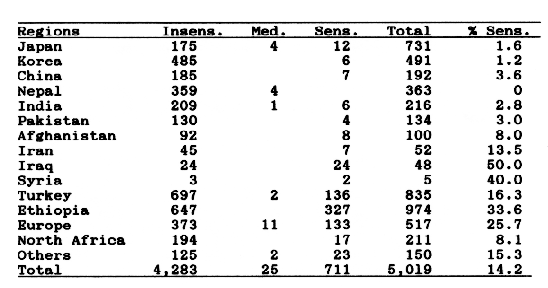

The author has found a clear-cut difference among barley varieties in sensitivity to an insecticide, diazinon (an organic phosphate). When the seedlings are sprayed with 1,000-2,000 ppm diazinon solution and kept at low temperature condition, the leaves of sensitive varieties are severely damaged and die, although the succeeding leaves grow rather normal. In 62 cross combinations between sensitive and insensitive varieties, it was shown that the diazinon sensitivity was controlled by a single dominant gene. However, the dominance was sometimes incomplete when the treatment was so severe. Mono-factorial segregation ratio was confirmed in some F3 populations examined (Table 1). Seedlings derived from 30 sensitive x sensitive crosses were sensitive with very few (0.3%) escaped plants, suggesting all the sensitive genes were allelic. The diazinon sensitive gene is named as Diz. Linkage analysis of the Diz is in progress. About 500 varieties of the world collection preserved in our Barley Germplasm Center were tested for the diazinon sensitivity. Table 2 shows the frequency of diazinon sensitive varieties from various regions in the world. The frequency of the sensitive varieties is 14% on the whole. Moderately sensitive varieties are quite few. Native varieties from Japan, Korea, China and Nepal are insensitive to diazinon. Sensitive varieties in Japan, Korea and China are two-rowed (VV) and/or bt for non-brittle rachis, which are believed to be occidental in origin. It is especially high in frequency in Iraq (50%) and Ethiopia (34%). A quarter of varieties introduced from Europe are sensitive to diazinon, and there is not a remarkable cline for the Diz frequency within Europe. It may be safe to estimate that :~he mutation of the sensitivity occurred in the Fertile Crescent or Ethiopia. As the sensitive gene was also found among the lines of a wild barley, H. spontaneum, the mutation might occur very long years ago. Otherwise, Diz gene might be introduced from sensitive cultivars to the wild barley by outcrossing. Because the diazinon sensitivity have not been selected directly during the evolution process of the barley, the biased distribution of diazinon sensitive varieties in the world may indicate the phylogenetical differentiation between the oriental and occidental barley varieties.

